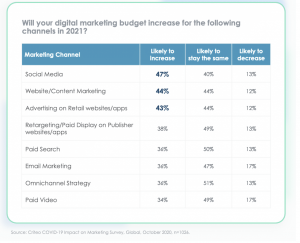By now, we are all aware of what the pandemic did to businesses. Aside from shuttering some, those left standing were faced with an ultimatum: go digital or go home.
The rush of building eCommerce platforms comes – online stores, carts, checkouts, and abandoned cart campaigns. Websites that hadn’t been updated in months (or, daresay, years) now needed to be consistently updated; apps and QR codes had to be created.
Like a scene out of a Broadway play, everyone was dancing across the digital marketing stage, trying to get ahead of the new demands. Then, COVID cases began to decrease. Children returned to the classroom, employees to work. Restaurant and retail doors swung wide open, ushering in those hungry for cappuccinos and clothing.
So it’s over, right? We can all go back to the way things were?
Nada. If you’re in touch with your customer base at all, you know that buying habits and customer interaction have changed. So now the real question becomes: how do we sustain what we’ve accomplished while looking ahead?
Drilling it Waaay Down
Long before the pandemic hit, marketers were identifying and penetrating ‘core audiences.’ We knew that the ‘blanket’ or ‘throw it at the wall and see what sticks’ approach from the 90s was no longer sustainable.
Now it’s all about defining customer segments and understanding the psychographics and demographics of those segments.
It’s all about the personas.
At BigPxl, we do this for every customer, spending a great deal of time identifying each of their ideal customer personas (ICP). We determine these personas or customers and try to understand their pain points, frustrations, and needs. We look to see precisely where they live and who they live with. We are the next-door neighbor who knows what everyone is doing on the block. Sounds creepy? It would if the intent was nefarious. However, we use our powers for good. Here’s a great explanation from Harvard Business Review:
“Beyond geography, we have learned marketing messages need to be personally relevant, aligned to an individual’s situation and values, as opposed to demographics, such as age and gender. Creating a personal, human connection within any commercial message requires defining consumer segments that describe people according to multiple dimensions that influence their purchasing behavior — from their psychographics to attitudinal characteristics.” – Harvard Business Review.
We know that this new way of marketing creates more meaningful engagement between the business and consumer. It also forges the path of least resistance to purchases, which is precisely what you want.
The Harvard Business Review went so far as to equate this new marketing strategy to online dating:
“For a long time, marketing was largely about buying mass reach or targeted reach at the best rates in media and hoping to convert it. So, it was like going to as many parties or bars as you could in the hope you would find that special someone. It was a world of spontaneity, serendipity, and, frankly, a lot of face-to-face encounters. Enter online dating and swiping through apps. Now, finding your perfect match may be less about chance and more about data and algorithms. In marketing terms, we have seen a shift from brand marketing to build reach to performance marketing to generate leads. The pandemic’s acceleration of digital channels only exacerbated that trend.” – The Harvard Review.
Online Engagement Attitudes (and Demands) Have Changed
Google changed its algorithm (again) in 2021 to create better engagement for searchers and visitors, requiring every website to become a basic 5-star hotel or dining experience. According to an article in Forbes, websites have now got to double-down in their approach to creating the optimal experience for every user. This includes site speed, design, colors, photos, video, and really, really relevant content. (In case you’re wondering, this is where all of our research and work on Ideal Customer Personas comes in).
I Love You, I Love You, I (Swear) I Love You
Like an amazing first date, it’s more than just a good experience. Digital marketing today is about creating, growing, and maintaining relationships. It’s a marriage chocked full of flowers, easy checkouts, fast load times, and relevant searches. Your pre-pandemic customers may have requested this, but your post-pandemic customers are demanding it. And if you can’t deliver, they will move on to someone who can give them the romance (experience) they want.
“For sales and marketing leaders in B2B organizations, this has necessitated a serious recasting of talent to identify people best suited to driving relationships in this new world of online interactions — a world that relies less on charm (and even an expense account) and more on insights and solutions. Trust will be built by and rewarded to those that listen to customer needs and then craft solutions to meet those needs. In a B2C context, trust also plays a tremendous role. It is foundational to the value exchange between a company and a consumer.” – Harvard Business Review.
Changing the Marketing Spend
In an online poll to businesses performed by the digital marketing agency Criteo during the pandemic, the following information about how they were going to spend marketing dollars showed a pivot from previous more conventional marketing spends:

We witnessed the same changes in spending with our client base, and we don’t see it change anytime soon. Why? Let’s review:
- More online shoppers/purchases
- Complete focus on individual silos of unique customer’s demographics, psychographics, and buying behavior (let’s not forget seasonality and market trends)
- Greater user engagement and experience required for all websites
These changes are pushing businesses to change the way they find, court, and communicate with their customers. That means managing the marketing budget accordingly.
We hope this information has helped you identify your business needs and build a robust digital marketing plan today and for 2022.





